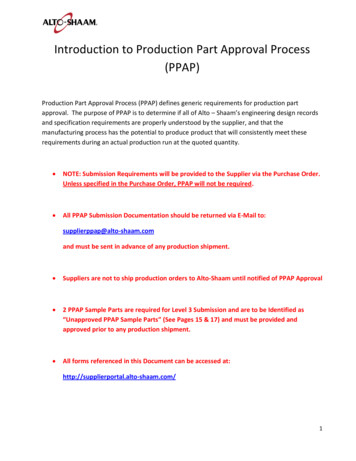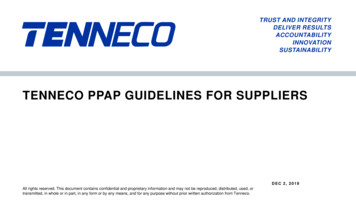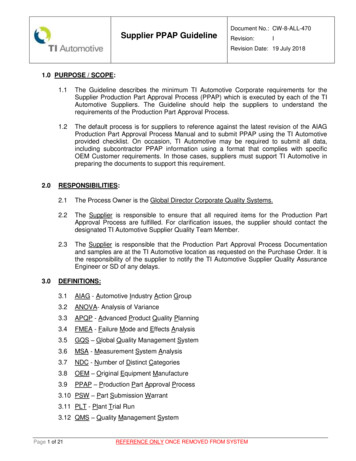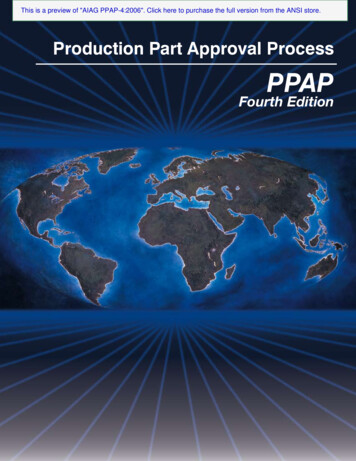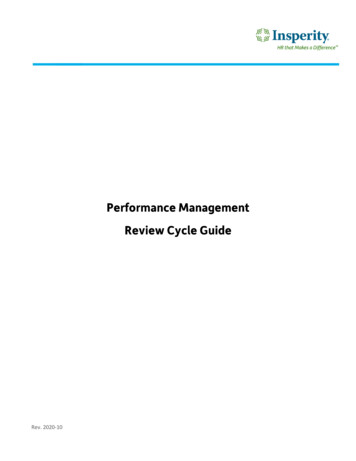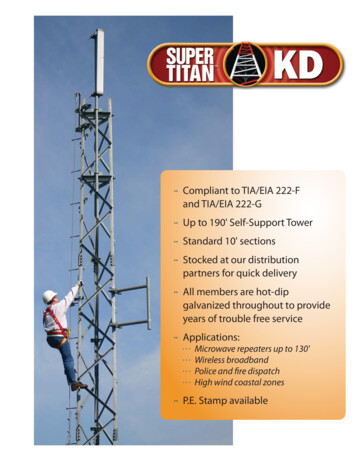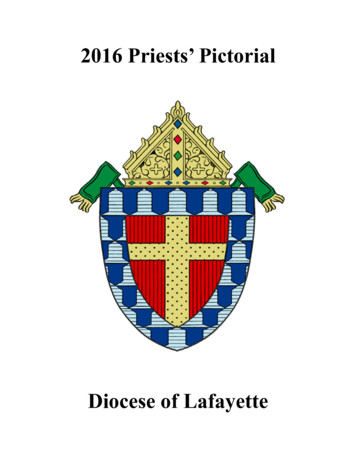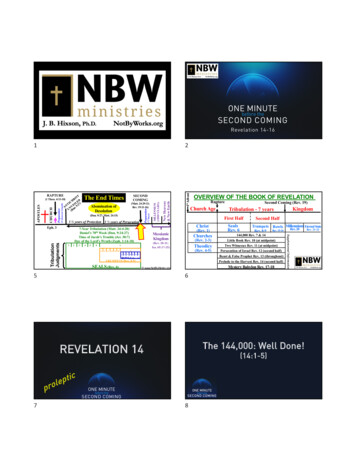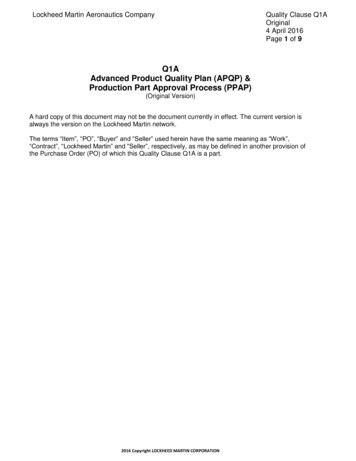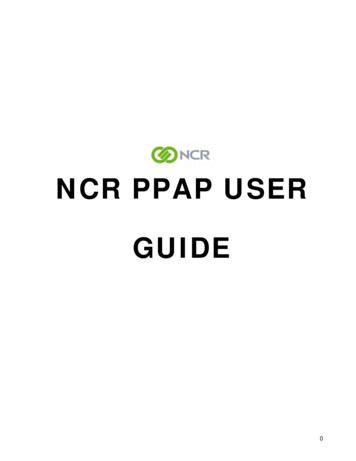
Transcription
NCR PPAP USERGUIDE0
REVISION HISTORYRev.DateOriginator(E-Signature)Approved By(E-Signature)AFeb - 2013Thivya. NRajesh KannaBOct - 2014S.GaneshaPandianPhani Kumar VutukuriDescription of ChangeInitial release1. PPAP level matrixmodified as per AIAG2. Section 7.2,7.2.1,7.2.2 &7.2.3 deleted3. ETQ flow added4. 9.3 RoHS standardrevision modifiedHow to fill up PPAPPlaybook5. Section 3,4,5 updated with“Allowed to use SuppliersOwn Format” – In line withPlaybook G6. Section 8,10,11,14 Explanation added in linewith Playbook GSpecial Comments:1
Table of Contents12345678PurposeWhen is a PPAP submission required?ScopeDefinitions & Terminologies4.1NCR PPAP4.2Other terms & Definitions4.3NCR PPAP Submission Levels4.4Disposition Status4.4.1Approval4.4.2Rejected4.4.3Interim ApprovalDocuments5.1PPAP PlaybookProcess Requirements6.1General Guidelines6.2Submission LevelsPPAP request to supplier7.1How will you receive PPAP Request from NCR?7.1.1What to do if PPAP request not received from PPAP team?7.1.2Whom to contact regarding part issues prior to PPAP submission?7.2How the supplier should submit PPAP?7.3What is Required Closure Date?7.4NCR PPAP ProcessExplanation on PPAP requirements8.1Requirement 1: Design Records8.2Requirement 1a: Balloon drawing8.3Requirement 2: Approved Engineering change document8.4Requirement 3: Customer Engineering Approval8.5Requirement 4: Design FMEA8.6Requirement 5: Process Flow Diagram8.7Requirement 6: Process Failure Mode and Effects Analysis (PFMEA)8.8Requirement 7: Control Plan8.9Requirement 8: Measurement System Analysis Studies (MSA)9.0Requirement 9: Dimensional Results9.1Requirement 10a: Material Test Report9.2Requirement 10b: Performance Test Results9.3Requirement 10c: RoHS Compliance Report9.4Requirement 10d: Salt Spray Test report9.5Requirement 11: Initial Process Studies9.6Requirement 12: Qualified Laboratory Documentation9.7Requirement 13: Appearance Report9.8Requirement 14: Sample product9.9Requirement 15: Master Sample10Requirement 16 Checking 1515151616161717171818182
10.110.210.310.410.5Requirement 17a: NCR Engineering ApprovalRequirement 17b: Sub Supplier Source details as per BOMRequirement 17c: Packaging test reportRequirement 18: Production Warrant (PW)Requirement 19: Bulk Material Checklist1819191919HOW TO COMPLETE PPAP PLAYBOOK?Section 1: How to fill out the “PPAP Submission Details”?Section 2: How to attach “Balloon Drawing”?Section 3: How to fill out the “Process Flow Diagram”?Section 4: How to fill out the “Process Failure Modes and Effects Analysis (PFMEA)”?Section 5: How to fill out the “Control Plan” sheet?Section 6: How to fill out the “Gage R&R Study”?Section 7: How to fill out the 9a.”Dimension report for Non Critical dimensions” sheet?Section 7.1: How to fill out the 9b.”Dimension Report for Critical dimensions” sheet?Section 8: How to fill out the “Material Test Report”?Section 9: How to fill out the “Performance Test Results”?Section 10: How to fill out the “RoHS Compliance Report”?Section 11: How to fill out the “Salt Spray Test Report “?Section 12: How to fill out the “Appearance Report “?Section 13: How to fill out the “List of Checking Aids”?Section 14: How to attach the “Engineering Approval Form”?Section 15: How to fill out the “Sub Supplier Source details as per BOM”?Section 16: How to fill out the “Packaging test report”?Section 17: How to fill out the “NCR Production Warrant (PW)”?2123272938414648505252545557585959603
ProcessOwner:PPAP TEAMEffective:Dec 2014Subject:Production Part ApprovalProcess (PPAP) requirementsNumber:445-9001377Reviewed:Rev:Dec 2014BSupplier Quality Mission:“Create processes & infrastructure within NCR and our supply base to insure all active parts areconsistently statistically capable, going into the supply chain”1. PurposeTo define NCR Production Part Approval Process for purchased parts To ensure that supplier can meet the manufacturability and quality requirements for thepurchased partsTo provide evidence that the customer engineering design record and specification requirementsare clearly understood and fulfilled by the supplierTo demonstrate that the established manufacturing process has the potential to produce the partthat consistently meets the all NCR requirements during the actual production run at the quotedproduction rateTo enable clear understanding of suppliers’ on NCR PPAP & relevant documentation requirements2. When is a PPAP submission required?In general, a PPAP is required anytime when a new part or a change to an existing part/process is beingplanned. It is the discretion of NCR to determine when and if a PPAP submission is required. As a Supplieryou should have all the necessary documentation ready for submission to NCR upon PPAP requestPPAP is not required for A and B Builds. This is required for only C Build.3. ScopeSuppliers may be requested for PPAP submission based on the following, but not limited to: NCR Design needsNCR Site / Business needsNCR New Product Introduction needsNCR Life cycle design changesChange in Material or Sub-supplierManufacturing location changeNew tool / Tooling modification at supplierSupplier / Sub-supplier mfg. process changesNCR PPAP process applies when there is a request for PPAP submission has been madeto the supplier4
4. Definitions & Terminologies4.1 NCR PPAP - A documentation package that is submitted to provide the evidence needed to show that allNCR engineering design record and specification requirements are properly understood by the supplierand that the designed process has the potential to produce parts consistently meeting theserequirements during an actual production run at the quoted production rate4.2 Other Terms & DefinitionsAIAG– Automotive Industry Action GroupASTM– American Society for Testing and MaterialsAT– Acceptance TestAVL– Approved Vendor ListAR– Appearance ReportDFMEA– Design Failure Mode Effects AnalysisETQ– Excellence thro QualityFAI– First Article InspectionGRR– Gauge Repeatability & ReproducibilityMSA– Measurement System AnalysisMIP– Manufacturing Incorporation PointNPI– New Product IntroductionPFD– Process Flow DiagramPFMEA– Process Failure Mode Effects AnalysisPW– Production WarrantRPN– Risk Priority NumberRoHS– Restriction of Hazardous SubstancesRFQ– Request for QuoteRCD– Required Closure DateRFC– Request for Change – NCR Internal system through which request for approval is sentto respective approval authority in the cases like not limited to change in the part, drawing, capabilityissues, etc.,SDE– Supplier Development EngineerSQE– Supplier Quality EngineerSCAR– Supplier Corrective Action ReportCAPA– Corrective Action Preventive ActionSOP– Standard Operating Procedure4.3 NCR PPAP Submission Levels Level1: Production Warrant & with RoHS/Appearance ReportLevel2: Production Warrant with Limited supporting documentsLevel3: Production Warrant with complete supporting documentsLevel4: Production Warrant and requested documentsLevel5: Production Warrant with Product samples & complete supporting document available forreview at manufacturing location of supplierE Audit: Production Warrant with requested documentsEngg FAI: Only requested documents to Engg Team4.4 Disposition StatusPPAP/PQV disposition status shall be communicated to the supplier as per below4.4.1Approval: Submission and accompanying documents meet NCR PPAP requirements. Approval shallbe provided through the Production Warrant document signed by the NCR PPAP Review teamrepresentative through ETQ. Supplier is authorized to ship the production parts to the appropriateNCR location.5
4.4.2Rejected: When the submitted PPAP/PQV E Audit documentation does not meet the NCRPPAP/PQV requirement. Rejection status is communicated to the supplier through ETQ with reasonsfor rejections clearly mentioned in the body of the mail. Supplier shall resubmit the correcteddocumentation for approval. Supplier shall also contact the PPAP team through the above mail id forany clarifications needed regarding the rejection.For any PPAP/PQV rejection, a CAPA will be raised against the failure mode. Supplier needs to closethe CAPA with their corrective action report in ETQ within the given time period.4.4.3 Interim Approval: Based on the business priority, an interim approval may be given for a PPAP withappropriate internal deviation approvals. It permits the shipment of material for production requirements on alimited time period or limited quantities.Supplier is responsible for implementing containment actions to ensure that only acceptable material is beingshipped to NCR. No additional shipments are authorized unless an extension of Interim approval is grantedby NCR.If the issue is related to NCR, upon completion of necessary actions by the concerned action owners, PPAPteam will offer final approval to the part and send the signed PW to the supplier.5. Documents5.1 PPAP Playbook - 497-04694796. Process Requirements6.1 General GuidelinesPPAP submission, when identified and/or communicated as required, must be completed and approvalobtained prior to shipment of the first production lot of parts. PPAP approval shall be communicated inthe form of NCR Production Warrant. PPAP submission is requested to you by NCR in the followingsituation, not necessarily limited to: New Part/Product or New ToolEngineering Changes to design records,Tooling Transfer, Replacement, RefurbishmentCorrection of DiscrepancyMaterial changeSub-supplier changeChange in Part ProcessingSub-supplier or Material Source ChangeSupplier Manufacturing location Change PPAP team assigns the PPAP Submission level during the PPAP request.Generally PPAP Levels differ only on the document submission Vs Retention. Hence it is theresponsibility of the supplier to keep updating all the necessary documents at their end per Level 3requirements and ensure it is readily available for NCR upon request.Also PPAP records should be maintained by the supplier and updated periodically as necessary toreflect current revision levels (e.g. PFMEA, Control plan, MSA records etc.) 6
6.2 Submission Levels:For PPAP/PQV & Engg FAI levels and the requirements, please refer FIG 1.FIG 1S – The supplier needs to submit the relevant documents to NCR and retain a copy of records ordocumentation items at appropriate locations (for Fast – To – Market – to be submitted within 90 days fromthe date of Interim Approval)R – The supplier shall retain the relevant documents at appropriate locations and make readily available toNCR upon request* - The supplier shall retain at appropriate locations, and submit to NCR upon request. NCR will advise whichdocuments to be submitted** - No additions shall be made to FAI requirements without full approval of all Engineering Directors*** - Drawing Notes confirmation ONLY7
Rto Supplier:S7. PPAP Requestow will you receiverPPAPP request froom NCR?7.1 HoPteam representativee will send reqquest for PPAAP and RCD wwith details off Part no, Revvision,NCR PPAPPPAPP level, NCR ProjectPPrograam name, etcc. through ET Q from mail ID ppap.ncr@@ncr.comOnce supplier receeive PPAP reqquest, supplieer needs to prrovide confirmmation through ETQFETQ Flow: Red Arrow denotes, currrent stage off the PPAP staatusPRequeestTo View PPAPFIG 1A Go to “My Oppen” ToT view the requestrdetaills of specific PartP Number,, just click thee row as markked above. New Windoww will open foor the PPAP reequested8
FIG 1BTo View thhe details of PPAPPRequesst PAP Part nummberClick on the PP eparate windoow open as shownsin Fig 1C1SeFIG 1C9
Click Tab “PPAP Level Requirement” as per Fig 1DFIG 1DRPPAAP Request to NCR – Reff FIG 1EReturn / ReverseUse thiis option for below reasoons. Please sharesfeedbaack on, reasoon for return1. Part not mannufactured byy Supplierufacture the part2. PO not availlable to manuRClossure Date (RCCD)3. Change in RequiredsPPAPP4. Other issue, not able to support10
CClick Tab“Initiate”Sub SScreen willPop-UpNo NNeed to editthis innformationSpeccify theReasson forreturnn/Changein RCCD hereFIG 1E11
7.1.1 What to do if PPAP request is not received from the PPAP team?1. Inform respective Commodity Manager that you have not received a PPAP request for the part2. Email to ppap.ncr@ncr.com and provide the Part Number, Revision and reason for which the PPAPis being done3. Based on the Input, PPAP team will give request as explained above.7.1.2 Whom to contact regarding part issues prior to PPAP submission?Send an e-mail to ppap.ncr@ncr.com and ppapreviewteam.ncr@ncr.com clearly explaining theissue regarding the part. Issue will be given to the appropriate person so that it can be resolved prior tosubmission.Note: Don’t submit any PPAP with known issues such as Out of Specification, Cpk fail etc.7.2 How the supplier should submit PPAP? Supplier must submit the PPAP Electronically through ETQ only.Supplier must use the latest NCR PPAP Playbook only. Latest NCR Playbook can be downloadedfrom http://www.ncr.com/documents/ppap-playbook.xls7.3 What is Required Closure date?RCD means Required Closure Date.How is RCD derived? NPI program required closure date, after confirmation from CM on readiness at supplier end.Based on historic development/PPAP approval lead time.What to do if you cannot meet RCD? Inform the PPAP team in advance if there are issues found with the parts that are preventing youfrom meeting RCD.PPAP team will revise RCD based upon the issue and reasons given.How is supplier measured in PPAP for RCD?Supplier is measured based on the number of Commitments/Targets met against the total numbers ofPPAPs. As an Example:Total PPAP 20,Number of PPAP approved on or before Committed Date 17,Number of PPAP approved after committed date 3CCD/RCD % --- 17/20 85.00%12
7.4 NCR PPAP PROCESS:Below is the High Level PPAP Process - Refer FIG 2FIG 28. Explanation on PPAP requirements8.1 Requirement 1: Design Records It is the copy of the drawing, if supplier is responsible for designing the part.The purpose of design records and ballooned drawings is to document the formal partprint and any additional engineering records for reference. This design record must beavailable upon request by NCR.8.2 Requirement1a: Balloon drawing A Ballooned drawing shows parts or assemblies in a drawing with numbered balloonsthat point to individual dimensions and requirements of the part. The numbers on theballooned drawing matches the numbers in the dimension results data sheets. ABallooned drawing must be attached in the respective tab of playbook for everysubmission level when there are dimensional results involved in a PPAPAll Part requirements on the drawings of NCR must be ballooned and numbered for referenceand measurement. These may includei.Dimensions and other geometric tolerances of partii.Physical and Mechanical properties (Heat treat Hardness, Plating thickness, Tensilestrength, Pull out force, etc.)iii.Chemical properties ( Cure time )iv.Visual features ( Color, texture, flash)v.Electrical requirements ( performance data, functional tests, etc.,)vi.Any other specified requirement that you have the capability to measure or that isdescribed in the print notes or referenced specificationsWhen the dimensions are specified at multiple locations, the data for each location should benumbered separately13
8.3 Requirement 2: Approved Engineering change document This section is used to cover anything not covered in the drawing print such as deviationapprovals, emails, feasibility studies, etc.,Please note that emails are only for clarification and they do not define any requirements8.4 Requirement 3: Customer Engineering Approval This section is no longer required from our suppliers. In the event it is required in the future, wewill inform the suppliersSupplier designed part shall have the evidence of Customer Engineering Approval for itsperformance and functional test8.5 Requirement 4: Design FMEA Design FMEA means Design Failure Modes and Effects Analysis and shows evidence that thepotential failures modes and their associated risks have been addressed to eliminate or minimizetheir effects through product design changes and improvementsDFMEA is required only when the part is designed by the supplier and should address all theCritical to Quality characteristics (CTQs) and any potential voice of customer inputs identified inNCR project scopeThe date on the DFMEA should show release prior to print release. The severity, Occurrence anddetection ratings are used when performing FMEA activities. These rating scales must bethcompliant with Automotive Industry Action Group (AIAG) guidelines (4 Edition)8.6 Requirement 5: Process Flow Diagram Process Flow Diagrams (PFD) are used to document and clarify all the steps involved in themanufacturing of a part. The Primary process steps must match the process steps addressed inPFMEA and the control plan. Process flow should include the entire manufacturing process flow (receiving through shipping)The Process Flow Diagram should include all of the key steps in the process and the offlineactivities (such as inspection, measurement, handling, etc.). The flow of non-conforming partssuch as rework parts, scrap parts should also be included. PFDs can be provided in any formatused within the organization.8.7 Requirement 6: Process Failure Modes and Effects Analysis (PFMEA) PFMEA stands for Process Failure Modes and Effects Analysis. This shows evidence that thepotential failure modes and the associated risks have been assessed during the manufacturingprocess design stage to eliminate or minimize their effects on the part/product.PFMEA can be submitted in NCR format or any AIAG compliant formatThe recommended rating scale for Severity, Occurrence and Detection are provided in the playbookitselfRisk Priority Number (RPN) 125 must have a correction action plan addressing the potential failuremode or potential cause for the failure mode. NCR also recommends any severity ranking 9 or 10 beaddressed with a corrective action plan8.8 Requirement 7: Control Plan The Control plan is a document which provides the information on controls that are being establishedin the process to control the Product and Process characteristics for all the processes involved in theproduction of the part.It is a derivative document of the Process Flow Diagram & PFMEA to address the Processcharacteristics & the failure modes in the process.14
8.9 Requirement 8: Measurement System Analysis Studies (MSA)The supplier shall have the applicable Measurement System Analysis studies, e.g., Gage R&R for all of themeasuring instruments and test equipment that are part of their internal quality system requirements. ForPPAP submission, the supplier needs to provide the Gage R&R study report for those instruments that areused for measuring Critical dimensions of the specific part in the actual production environment. Please notethat these instruments should have been addressed in the control plan of the respective manufacturingprocess9.0 Requirement 9: Dimensional ResultsSupplier provides evidence that dimensional verifications required by the design record have been completedand results indicate compliance with specified requirements. Supplier shall record all dimensions (exceptreference dimensions), characteristics, and specifications as noted on the design record.We recommend suppliers use the NCR format only for the dimensional results as there are specific Cpkrequirements applicable to NCR only.If production parts are produced from more than one cavity, mold/ tool, Machine supplier shall submitdimensional reports from each cavity.Definitions of critical dimensions are as below:1. Critical Dimensions: Identified by an “Obround” in drawings released after Feb 2013 requires 30sample measurements with Cpk 1.67 – Refer FIG 32. Non Critical Dimension: All other dimensions (Except Reference Dimensions) regardless of thenumber of decimal places are considered to be Non Critical dimensions and requires 5 samplesmeasurement with no Cpk requirement.FIG 39.1 Requirement10a: Material Test ReportThe Material Test Report is where the supplier submits the evidence that they are using the correct Rawmaterial/Grade as per design record. Supplier can submit the Material certificate either by getting one fromyour Raw material supplier or by doing the certification testing at an outside laboratory.The Material Test Report is required for all Parent and child level parts wherever design record calls formaterial specification requirements.15
Note: Some of the materials specified in the NCR drawing may not available in the supplier’s region. AnEquivalent Material Document is available for reference/use when this situation occurs. Thedocument number is (009-0028294 – Latest Version).We expect the suppliers to use only the approved alternate material as per the above document.NCR will not accept any other material without prior approval from NCR Engineering.NCR expects the suppliers to call out any Material difference issues and resolve them throughthe NCR Commodity team. This action should be done through feasibility analysis at the time ofpart development.If the supplier uses any alternate material, the supplier needs to provide the RFC approvalreference in the PPAP document while submission to NCR PPAP Team.UL Certification:The Supplier needs to provide UL certificate for Plastic parts, Labels, Gaskets and Adhesives used whereverapplicable.9.2 Requirement10b: Performance Test Results:Performance Test Results are the summary of every test performed on a part. The supplier shall performtests for all the part(s) or product material(s) when performance or functional requirements are specified inthe drawing. It includes ICT, FT, continuity Tests etc. The summary is usually on a form which lists eachindividual test, when it was performed, the specification, results and the assessment of pass/fail.Performance Test Results may be presented in any convenient format. Attach the “Performance Test resultssheet” in the PPAP Playbook.9.3 Requirement 10c: RoHS Compliance ReportNCR is a RoHS compliant Company. All parts supplied to NCR should be RoHS compliant as per EuropeanUnion Directive 2011/65/EC or as per NCR Product Environmental Specification – 497-0478705 (LatestVersion)Supplier can provide evidence of RoHS compliance Report in any of the following ways Attach RoHS compliance report from the original Raw material supplierAttach RoHS Test Lab report either from In-house or Outside laboratoryDeclare RoHS compliance by providing a Certificate of Conformance (COC) in the company letterhead with authorized signature.Note: For the first 2 conditions supplier should provide separate RoHS compliance report for raw material andplating where applicable. For the third condition, a single self-declaration is enough as a whole Part/ Product9.4 Requirement 10d: Salt Spray Test ReportSalt Spray Test requirement generally applicable for any coated/Plated parts. Supplier needs to provide theevidence of parts meeting the Salt Spray Test requirements as per NCR Plating Specification mentioned inthe drawing.Commonly used plating specifications are listed below.1. Specification for Alu-Zinc & Galvanized Pre-Plated Steel as per document 009-0024847(LatestVersion)2. Specification for Zinc Plating as per document 009-0020301(Latest Version)3. Specification for EZ & Organic Pre-coated Steel Sheet as per document 009-0022100(LatestVersion)Suppliers are advised to contact NCR Team to get the above specifications if required.In addition to the Salt Spray Test Report, coating thickness value for a Minimum of 5 samples need to bemeasured and reported in “Dimension Report – Non critical dimensions” sheet.16
9.5 Requirement 11: Initial Process Studies Initial process studies refer to the process performance or process capability studies done for theCritical dimensions during the PPAP parts production.Typically automotive and other industries take 125 sample readings for the critical dimension and dothe capability analysis.NCR’s dimension report format (“Dimension Report - Critical dimensions” worksheet of the playbook)covers the initial process study aspect for the PPAP parts.It is sufficient to attach above worksheet alone and there is no need to attach separate processstudy reports in the PPAP documentation. If you have any such separate study report, retain at yourend and upon request from NCR, you can submit to NCRPlease note that Critical dimensions (marked with Obround in the drawing) need to meet minimumCpk value of 1.67 and for Non-critical dimensions, it should be within specification. If you are notable to meet the required Cpk, please contact your assigned SQE for any technical assistance andensure Cpk related issues are resolved before submitting the PPAP document to NCR9.6 Requirement 12: Qualified Laboratory DocumentationInspection and testing for PPAP shall be performed by a qualified laboratory as defined by customerrequirements (e.g., an accredited laboratory). The qualified laboratory (internal or external) shall have alaboratory scope and documentation showing that the laboratory is qualified for the type of measurements ortests conducted.When an external/commercial laboratory is used, the organization shall submit the test results on thelaboratory letterhead or the normal laboratory report format. The name of the laboratory that performed thetests, the date (s) of the tests, and the standards used to run the tests shall be identified.9.7 Requirement 13: Appearance Report:Appearance report should contain the part images, Part Marking images, Painting test requirements likeAdhesion test report, RAL shade card color confirmation wherever applicable as per NCR drawing andspecification requirements.Supplier needs to measure/Confirm the possible drawing notes in Appearance ReportPart Image Report: Supplier needs to provide relevant image(s) of the part in order to visualize the physicalpart clearly AND needs to attach the relevant image(s) of markings as specified in drawing notesExample: Recycle symbol, Part no, UL no, Molders name, Ejection Location etc.Adhesion Test Results for Painted Parts: Supplier needs to attach the Adhesion Test results for the Paintedparts as per below ASTM standard17
Adhesion by Tape TestFor Metallic Substrates:Test in accordance with ASTM D-3359. A rating of 5* using method B is (cross-cut tap test) isrequired.*The edges of the cuts are completely smooth; none of the squares of the lattice aredetached.RAL SHADE CARD DETAILS for Painted Parts:Shade Card – It is a Sample Color chip given by the Paint Manufacturer as per the RAL code of designrecord and which is used as a reference to cross verify the painted partsSupplier needs to attach the part image of the painted surface which matches to the shade card9.8 Requirement 14: Sample ProductSupplier shall submit the PPAP samples to NCR on request.It is advised to identify the PPAP samples appropriately while sending them to NCR so that those parts canbe traced better at NCR for further assembly trials/testing etc9.9 Requirement 15: Master SampleIt is recommended that supplier retain one or more samples of the PPAP parts at their location withappropriate identification and traceability as per their internal quality system requirements. This will be helpfulfor any future references.For any aesthetic or other visual related parts, it is advised that supplier can get necessary approvals throughauthorized signature on the master samples by their assigned SQE.(E.g.: Molded parts with accepted level of warpage, shrinkage marks, burr levels in sheet metal parts, anyplated or painted parts, AND other visual related elements )10.0 Requirement 16: Checking AidsChecking aid refers to the document containing the list of measuring instruments, gauges, equipment’s andother fixtures used for qualifying the parts during regular production.Checking aid should include the calibration status for all the instrument, gages and equipment.10.1 Requirement 17a: NCR Engineering ApprovalEngineering approval refers to formal approval from NCR Engineering team for the parts involved in thePPAP.Prior to PPAP submission, supplier needs to submit samples of the new part to NCR engineering forvalidation and other testing. Engineering will provide approval based upon the satisfactory validation & Testresults.During development stage, respective NCR commodity will advise the suppliers on sample size and NCREngineering location where the parts to be sent for engineering approvals.The following type of parts will fall under this category but are not limited to - Electronic parts like PCBs,Cables, Harnesses, Sensors, Solenoids, Motors, Locks and catalogue parts like bearings, springs, grease,screws, washers etc.18
10.2 Requirement 17b: Sub Supplier Source details as per BOMSupplier shall provide their sub supplier source details for all the parts listed in BOM10.3 Requirement 17c: Packaging test reportThe Packaging Test Report is where the supplier submits the evidence that they are using the correctpackaging to safe transit of the material. Supplier can submit the Packaging test report either by himself byperforming test as per ISTA procedure or by doing the certification testing at an outside laboratory.10.4 Requirement 18: Production Warrant (PW):Upon completion of all PPAP requirements, supplier shall complete the Production Warrant (PW).A separate PW shall be completed for each NCR part number for which the PPAP is requested by NCRunless otherwise agreed to by the authorized NCR representative.The PW is the document through which the supplier confirms and gives assurance that the submitted partsmeet all of the specifications, material, appearance and other requirements of NCR and has the capability tomeet the NCR requirements consistentlyIf the supplier is not able to meet any of the NCR requirements, the details of the failure
PPAP level matrix modified as per AIAG 2. Section 7.2,7.2.1,7.2.2 & 7.2.3 deleted 3. ETQ flow added 4. 9.3 RoHS standard revision modified How to fill up PPAP Playbook 5. Section 3,4,5 updated with "Allowed to use Suppliers Own Format" - In line with Playbook G 6. Section 8,10,11,14 -

